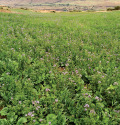From the desk of john dobberstein Another Cheap Shot at No-Till
An ag publication says farmers are destroying diversity for crops getting lower yields. But there’s a hole in that theory.
southern plains perspective Soil Health ‘Bundled Benefits’ are Getting More Attention
Clay Pope shares some studies that show how soil health practices implemented in priority watersheds can result in improvements in water quality while also reducing greenhouse gas reductions. Pope also shares a new tool from American Farmland Trust that can help folks involved in conservation work more easily identify how much of a positive impact soil health practices are having in helping mitigate climate change.
Feature What I've Learned from No-Tilling: Adding Diversity and Livestock for a Stronger Bottom Line — Now and in the Future
Playing the long game means this no-tiller Noah Williams’ profits may be more impressive when viewed by the decade rather than the year.
Video The No-Tillers Who Own the World's Largest Tractor
On Sept. 1, 2020, at the 2020 Farm Progress Show Media Event, No-Till Farmer editors met up with Robert and Randy Williams, two no-tilling brothers who own the Big Bud 747, the world’s largest tractor. The Williams brothers talked shop about what makes the Big Bud unique, what it does on their farm and what their no-till model looks like.
Podcast Roy Applequist on Building the First Great Plains No-Till Grain Drill
For this episode of the No-Till Farmer podcast, brought to you by Mosaic Susterra, No-Till Farmer editor Frank Lessiter reminisces with Roy about how he got involved with building no-till equipment.
No-till award Grower Nominations Sought for Responsible Nutrient Practitioners Award
No-Till Farmer and AgroLiquid are currently seeking nominations of no-tillers and strip-tillers for the 13th class of Responsible Nutrient Management Practitioners. Three growers will be awarded and recognized during the 29th annual National No-Tillage Conference in Indianapolis, Ind., Jan. 12-15, 2021. Nominate a no-tiller today!

National cover crop summit Discover Profit-Boosting Ideas and Advice During the Online National Cover Crop Summit, November 17-18, 2020
More than 5,000 ag professionals from all 50 states and 45 countries joined us for the first two National Cover Crop Summits to learn how to harness the full potential of a cover crop system to protect soils and increase farm profits. The National Cover Crop Summit is returning November 17-18, 2020, and will feature a series of profit-building presentations from some of today's leading cover crop experts. Sign up for this FREE ONLINE EVENT today that has earned a 99% attendee satisfaction rating. Register here »
Check out the latest innovations from leading industry suppliers!
|
No-Till News New Way of Analyzing Soil Organic Matter Will Help Predict Climate Change
A new way of analyzing the chemical composition of soil organic matter will help scientists predict how soils store carbon — and how soil carbon may affect climate in the future, says a Baylor University researcher.
Forage Hazards Following a Freeze Event
When cover crops become a forage crop it’s important to treat them as such and to understand the risks associated with utilizing them as supplemental forage, especially as our environmental conditions begin to change. This becomes critical as we move into fall, says University of Nebraska Extension.
High Moisture Top Risk for Binned Canola, Growers Say
A Canola Watch Twitter poll in mid-September asked farmers, “Which risk are you most concerned about for your binned (or soon to be binned) canola?” Some 45% of respondents chose “Nothing major so far,” which is good, but 38% said moisture, 10% said green seed and 7% said dockage.
EPA To Make Dicamba Registration Decision by Mid-October
In the wake of a June court ruling vacating 3 dicamba registrations that were set to expire later this year, the Environmental Protection Agency is reviewing dicamba decisions so farmers will have time to make purchasing decisions for next season.

















